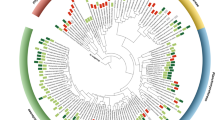Abstract
It is known that bacterial group II phosphopantetheinyl transferases (PPTases) usually phosphopantetheinylate acyl carrier proteins (ACPs) involved in the secondary metabolism. For example, a bacterial group II PPTase SchPPT has been known to phosphopantetheinylate only ACPs involved in secondary metabolism, such as scn ACP0-2 and scn ACP7. In this study, we found two bacterial group II PPTases, Hppt and Sppt, could phosphopantetheinylate not only scn ACP0-2 and scn ACP7, but also sch FAS ACP, an ACP involved in primary metabolism. Swapping of the N terminus and C terminus of PPTases showed that (i) both the hybrids Hppt-Sppt and Sppt-Hppt could phosphopantetheinylate sch FAS ACP but not scn ACP0-2; (ii) both the hybrids Sppt-SchPPT and SchPPT-Sppt lost abilities to phosphopantetheinylate sch FAS ACP and scn ACP0-2. Hppt and Sppt represent group II PPTases which phosphopantetheinylate both ACPs involved in primary metabolism and ACPs involved in secondary metabolism.





Similar content being viewed by others
References
Barekzi N, Joshi S, Irwin S, Ontl T, Schweizer HP (2004) Genetic characterization of pcpS, encoding the multifunctional phosphopantetheinyl transferase of Pseudomonas aeruginosa. Microbiology 150:795–803
Beld J, Sonnenschein EC, Vickery CR, Noel JP, Burkart MD (2014) The phosphopantetheinyl transferases: catalysis of a post-translational modification crucial for life. Nat Prod Rep 31:61–108
Bunkoczi G, Pasta S, Joshi A, Wu X, Kavanagh KL, Smith S, Oppermann U (2007) Mechanism and substrate recognition of human holo ACP synthase. Chem Biol 14:1243–1253
Copp JN, Roberts AA, Marahiel MA, Neilan BA (2007) Characterization of PPTNs, a cyanobacterial phosphopantetheinyl transferase from Nodularia spumigena NSOR10. J Bacteriol 189:3133–3139
Cox RJ, Crosby J, Daltrop O, Glod F, Jarzabek ME, Nicholson TP, Reed M, Simpson TJ, Smith LH, Soulas F, Szafranska AE, Westcott J (2002) Streptomyces coelicolor phosphopantetheinyl transferase: a promiscuous activator of polyketide and fatty acid synthase acyl carrier proteins. J Chem Soc Perkin Trans 1:1644–1649
Dall’aglio P, Arthur CJ, Williams C, Vasilakis K, Maple HJ, Crosby J, Crump MP, Hadfield AT (2011) Analysis of Streptomyces coelicolor phosphopantetheinyl transferase, AcpS, reveals the basis for relaxed substrate specificity. Biochemistry 50:5704–5717
Dereeper A, Guignon V, Blanc G, Audic S, Buffet S, Chevenet F, Dufayard JF, Guindon S, Lefort V, Lescot M, Claverie JM, Gascuel O (2008) Phylogeny.fr: robust phylogenetic analysis for the non-specialist. Nucleic Acids Res 36:W465–W469
Fischbach MA, Walsh CT (2006) Assembly-line enzymology for polyketide and nonribosomal peptide antibiotics: logic, machinery, and mechanisms. Chem Rev 106:3468–3496
Hopwood DA (1997) Genetic contributions to understanding polyketide synthases. Chem Rev 97:2465–2498
Huang Y, Wendt-Pienkowski E, Shen B (2006) A dedicated phosphopantetheinyl transferase for the fredericamycin polyketide synthase from Streptomyces griseus. J Biol Chem 281:29660–29668
Jiang H, Wang YY, Ran XX, Fan WM, Jiang XH, Guan WJ, Li YQ (2013) Improvement of natamycin production by engineering of phosphopantetheinyl transferases in Streptomyces chattanoogensis L10. Appl Environ Microbiol 79:3346–3354
Lambalot RH, Walsh CT (1997) Holo-[acyl-carrier-protein] synthase of Escherichia coli. Methods Enzymol 279:254–262
Larkin MA, Blackshields G, Brown NP, Chenna R, McGettigan PA, McWilliam H, Valentin F, Wallace IM, Wilm A, Lopez R, Thompson JD, Gibson TJ, Higgins DG (2007) Clustal W and Clustal X version 2.0. Bioinformatics 23:2947–2948
Lu YW, San Roman AK, Gehring AM (2008) Role of phosphopantetheinyl transferase genes in antibiotic production by Streptomyces coelicolor. J Bacteriol 190:6903–6908
Murugan E, Liang ZX (2008) Evidence for a novel phosphopantetheinyl transferase domain in the polyketide synthase for enediyne biosynthesis. FEBS Lett 582:1097–1103
Quadri LE, Weinreb PH, Lei M, Nakano MM, Zuber P, Walsh CT (1998) Characterization of Sfp, a Bacillus subtilis phosphopantetheinyl transferase for peptidyl carrier protein domains in peptide synthetases. Biochemistry 37:1585–1595
Reuter K, Mofid MR, Marahiel MA, Ficner R (1999) Crystal structure of the surfactin synthetase-activating enzyme sfp: a prototype of the 4′-phosphopantetheinyl transferase superfamily. EMBO J 18:6823–6831
Roberts AA, Copp JN, Marahiel MA, Neilan BA (2009) The Synechocystis sp. PCC6803 Sfp-type phosphopantetheinyl transferase does not possess characteristic broad-range activity. ChemBioChem 10:1869–1877
Sanchez C, Du L, Edwards DJ, Toney MD, Shen B (2001) Cloning and characterization of a phosphopantetheinyl transferase from Streptomyces verticillus ATCC15003, the producer of the hybrid peptide-polyketide antitumor drug bleomycin. Chem Biol 8:725–738
Shen B (2003) Polyketide biosynthesis beyond the type I, II and III polyketide synthase paradigms. Curr Opin Chem Biol 7:285–295
Tamura K, Dudley J, Nei M, Kumar S (2007) MEGA4: molecular evolutionary genetics analysis (MEGA) software version 4.0. Mol Biol Evol 24:1596–1599
Wang YY, Li YD, Liu JB, Ran XX, Guo YY, Ren NN, Chen X, Jiang H, Li YQ (2014) Characterization and evolutionary implications of the triad Asp-Xxx-Glu in Group II phosphopantetheinyl transferases. PLoS One 9:e103031
Zhang J, Van Lanen SG, Ju J, Liu W, Dorrestein PC, Li W, Kelleher NL, Shen B (2008) A phosphopantetheinylating polyketide synthase producing a linear polyene to initiate enediyne antitumor antibiotic biosynthesis. Proc Natl Acad Sci USA 105:1460–1465
Acknowledgments
This work was supported by Zhejiang Provincial Natural Science Foundation of China LZ12C01001, National Natural Science Foundation of China 31200600, National High Technology Research & Development Program of China (863 Program) 2012AA02A706 and 2012AA022107, and National Key Technologies R & D Program of China 2011BAD23B05-2. The authors of this manuscript have no conflict of interest to declare.
Author information
Authors and Affiliations
Corresponding author
Rights and permissions
About this article
Cite this article
Wang, YY., Zhang, XS., Ren, NN. et al. Two Bacterial Group II Phosphopantetheinyl Transferases Involved in Both Primary Metabolism and Secondary Metabolism. Curr Microbiol 70, 390–397 (2015). https://doi.org/10.1007/s00284-014-0735-0
Received:
Accepted:
Published:
Issue Date:
DOI: https://doi.org/10.1007/s00284-014-0735-0




